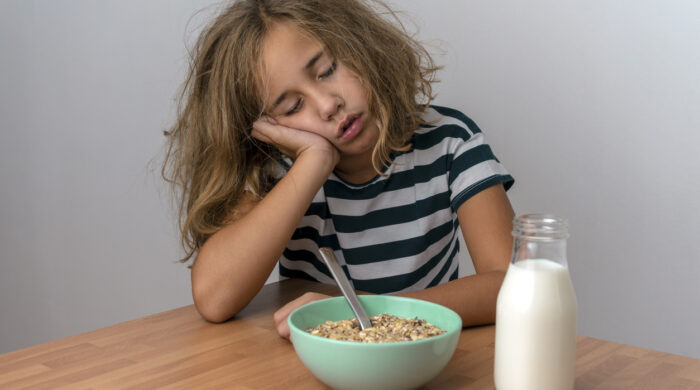New parents look forward to their infant sleeping through the night. Usually that dream comes true a few years later, by the time kids start school.
So when a school-aged child has trouble sleeping, it feels like something must be wrong. Sleep hygiene is usually at the root of the problem, but sometimes there can be an underlying medical condition.
“Children nowadays are not getting enough sleep. Multiple studies have shown that school, electronics in the bedroom, not prioritizing sleep, and lack of a consistent sleep schedule are all leading to sleep deprivation,” said Abigail Doyle, a DO in WWMG’s Pulmonary and Sleep Medicine clinic.
How much sleep do children need?
“Sleep needs decrease as we age,” Doyle said. While each individual child is different, on average:
- Infants need 15-17 hours per night
- Preschoolers need 10-13 hours
- Elementary students and tweens need 9-11 hours
- Teens need 8-10 hours
Sleepwalking, insomnia, nightmares, night terrors, and confusional arousals are common sleep issues seen in younger children. Fortunately, kids grow out of most of the sleep problems they experience in elementary school.
Sleep disruptions “tend to decrease in frequency as the child ages, and shouldn’t be cause for alarm,” said Doyle. Although occasional sleep disruptions, called parasomnia, are harmless, severe sleep interruption can lead to sleep deprivation, which has serious consequences.
Consequences of lack of sleep
A sleep deprived child may act sleepy and cranky during the day. They may nod off during class or on car rides. Continual sleep disruption can lead to symptoms of sleep deprivation, including:
- Hyperactivity
- Inattention
- impaired executive functioning, such as problem-solving, organization and motivation
- impaired memory formation and consolidation, which are important to learning.
In addition, insufficient sleep can impair the proper function of the immune system to fight germs and cause a delay in growth, as growth hormone is secreted during sleep,” Doyle explained.
Alternately, exhaustion can trigger sleep disruptions in a child. Exhausted kids are just as likely to resist napping and show behavioral problems that adults don’t always associate with sleepiness.
When sleep disruption creates symptoms during the day, it’s time to seek medical help.
Common Sleep Problems in Children
Sleepwalking
To keep sleepwalkers safe, parents should make sure doors, windows, and weapons are all locked up, but no medical intervention is required. Waking a sleepwalker is not dangerous, but Doyle says it’s unnecessary. The best response is to gently lead the sleepwalking child right back to bed.
Confusional arousal and childhood night terrors
Confusional arousal and sleep terrors (also called night terrors) tend to occur in the first third of the night. Although the child is in deep sleep, they will appear awake and seem distressed and inconsolable for up to thirty minutes.
Night terrors are often accompanied by increased heart rate and a flushed face. Unlike nightmares, the child has no memory of the night terror episode when they awake.
Counterintuitively, waking the child up about 15 minutes before the usual onset of these episodes can prevent them. “You are kind of resetting their transition into deep sleep,” Doyle said.
Sleep paralysis and nightmares
Sleep paralysis and nightmares occur during REM sleep, usually in the later third of the night.
“In sleep paralysis, your mind wakes up before the body so you have the feeling you can’t move at all,” said Doyle. Because sleep paralysis can involve hallucinations, it can be hard to tell from a nightmare.
Most children experience occasional nightmares, but frequent nightmares over an extended period of time could be the result of post-traumatic stress or chronic anxiety.
Sleep Apnea
“Large tonsils and adenoids is the leading cause of sleep apnea in children,” said Doyle. In this case, a tonsillectomy will usually eliminate mild sleep apnea.
She adds, “Snoring by itself is not a problem,” but it can be a symptom of sleep apnea. If a child stops breathing during the night, or snores frequently and shows signs of insufficient sleep, parents should have their child screened for sleep apnea.
Obesity can also be a factor. With rising childhood obesity rates, sleep apnea has become more common in kids. When obesity is a factor, weight loss can improve a child’s sleep as well as reduce the risk of diabetes and high blood pressure.
If a child still experiences apnea after these issues are addressed, an overnight study at a sleep center will determine if medical treatment is needed.
Improving Sleep Hygiene
The basics of good sleep hygiene are simple, but many families struggle to put them into practice. “The bedroom really should be for sleeping only,” said Doyle.
That’s hard for kids, where the bedroom is also a playroom and homework space. But parents can at least keep electronics out of the bedroom and create a dedicated sleeping zone around the bed.
Create a Consistent Sleep Routine
It’s hard to overstate the importance of a fixed routine with regular bedtimes and waking times to set biological rhythms. Most kids need thirty minutes to an hour to wind down from full activity to sleep, and a bedtime routine helps guide that process while also creating positive sleep associations. Although it’s tempting to relax the routine on weekends, it can disrupt good habits.
“Parents need to be strong. We have to enforce limits and be consistent,” Doyle said. It can take a couple weeks to establish a new routine, especially when kids are resistant to change. If you’ve maintained a routine for weeks without progress, it may be time to consult a sleep specialist.
For children or adults, seeing a sleep specialist may not require a referral (depending on your insurance). If your insurance does require a referral or you’re not sure whether a sleep study is the right approach, talk with your WWMG primary care provider about your concerns. They can assess the situation and recommend appropriate treatment to help your child get their sleep back on track.
